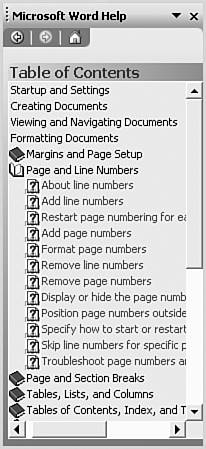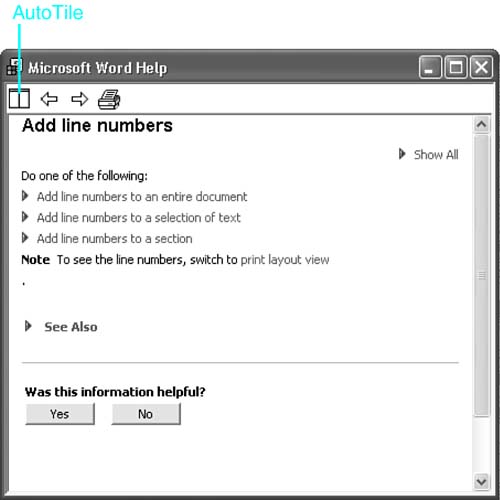Getting Help
Word provides extensive online help, easily accessible through the Type a Question for Help box and the Help task pane. These tools bring together Help resources that were placed on your hard disk when you installed Word, as well as Help resources at Microsoft Office Online, part of Microsoft's Web site. In the following sections, you'll learn how to make the most of both sets of resources.
Help from the Type a Question for Help Box
The easiest way to get help is to type a question in the Type a Question for Help box on the right edge of the menu bar. After you type the question, press Enter; Word displays the Search Results task pane, listing pages that may contain the answer (see Figure 2.36). If you are connected to the Internet, Word will draw on the Help content stored on your computer, as well as additional help from Microsoft Office Online.
Figure 2.36. Working with the Type a Question for Help box (in this case, asking about Styles).

If the first several page names do not appear to contain the answer, you can scroll down to see more. To view one of the help pages, click on its name.
When you do, Microsoft Word Help appears, displaying a page of help. This page may itself contain blue hyperlinks that connect you to more help; for example, if you asked for help troubleshooting a feature, Word may list several problems. Clicking one provides the solution.
TIP
This isn't "Jeopardy": You don't have to phrase your query in the form of a question. If you just know a term or phrase?such as "word count" or "insert date"?you can usually get the help you're looking for.
TIP
Word remembers questions you've asked recently. If you need help on the same topic again, you can select a question you asked previously from the Type a Question for Help drop-down list box.
NOTE
In Word 2003, as in previous versions of Word, you can also get online help by asking questions of the animated Office Assistant. However, in Word 2003, the Office Assistant appears only when you summon it by choosing Help, Show the Office Assistant.
Type a question in the What Would You Like to Do box, and Word displays the Help pages it thinks are most likely to include the answers.
Refining Your Help Searches
Sometimes the first set of results you get doesn't include the specific answer you're looking for. You may be able to get better results by refining your search, as described here:
Rephrase the terminology in your question. If you know it, use Microsoft's terminology for the feature you're interested in. For example, if you wanted to know how to create styles for large text headlines, use Word's term?headings?rather than headlines.
Add more detail to your query: "format text as superscript" will get you a more targeted answer than "formatting."
If one answer is closer to being relevant than the others, click the gray category link under it, to display closely related content
Make sure that your query doesn't contain any misspellings
Browsing the Microsoft Word Help Book
Some users prefer to browse Microsoft Word's help system as if it were a book. To do so, choose Help, Microsoft Word Help to display the Microsoft Word Help task pane. Then, click Table of Contents, and browse to the help page you want to read (see Figure 2.37).
Figure 2.37. Browsing the Table of Contents to find a specific Help page.

Using AutoTiling to Keep Help Visible as You Work
By default, when you display a help window, the help window is superimposed over your editing window. However, you'll often want to display the help window and the editing window next to each other so that you can more easily follow the step-by-step instructions that appear in the help window.
In Word 2003, it is easy to display both windows side by side. In the Microsoft Word Help window, click the AutoTile button (see Figure 2.38). When you do, Word hides the Help (Search Results) task pane to leave more room for you to work. |
Figure 2.38. The Microsoft Word Help window, untiled.

Sometimes you'll want to turn off AutoTiling and display the help window above the Word editing window again?perhaps to view lengthier instructions. To toggle AutoTiling off, click the Untile button (see Figure 2.39). When you do, Word displays the Help (Search Results) task pane again.
Figure 2.39. The Microsoft Word Help window, tiled.

Getting Help from Other Office Users
Microsoft maintains heavily trafficked newsgroups in which users can ask questions about Microsoft Word (and other Office applications), and other users can volunteer answers. In some cases, official "Microsoft Most Valuable Professional" expert volunteers may answer your questions. |
In Word 2003, you can get to these newsgroups straight from the Search Results task pane. To do so, scroll down the list of results Word has displayed, and click Ask Other Office Users.
Internet Explorer loads, displaying the main page of Microsoft's Newsgroup application (see Figure 2.40). Click Word to display Microsoft's list of Word newsgroups; then click on the newsgroup you want to browse or participate in.
Figure 2.40. Microsoft's online newsgroup community.

In some cases, your question will already have been asked and answered. If not, you can ask a new question by clicking New Post. The Post a New Message window appears; enter your name, email address, subject, and message, and click Send.
Using Other Web-Based Help from Office on Microsoft.com
Microsoft brings together many additional online Help resources in the Microsoft Word Help task pane (see Figure 2.41). You can click |
Connect to Office on Microsoft.com to display the main page of Microsoft's online support site in Internet Explorer. From here, you can connect to news about Office, feature articles displaying help on selected topics, and new Office-related downloads.
Get the Latest News About Microsoft Word to display the main page of Microsoft's Word support site?step-by-step help organized around categories such as Mass Mailings and Security and Privacy.
Automatically Update This List from the Web to retrieve brand-new information about Office into your Microsoft Word Help task pane.
Assistance to display online suggestions and resources for using Word and Office in new and better ways.
Training to link to Microsoft's new online training courses for Word and Office, designed to walk you through selected tasks visually.
Communities to link to Microsoft's online newsgroups, discussed earlier in this chapter in the section "Getting Help from Other Office Users."
Office Update to connect with a Microsoft Web page that can scan Word or Office to determine whether you need to install updates.
What's New to display a list of new features in Word 2003.
Contact Us to display a list of options for getting additional help from Microsoft.
Accessibility Help to display Help about features that make Word more accessible to users with limited dexterity, low vision, or other disabilities.
Online Content Settings to display the Service Options dialog box, from where you control which online Help resources are sent to your computer, and how they are displayed.
Figure 2.41. Microsoft Word Help task pane.








